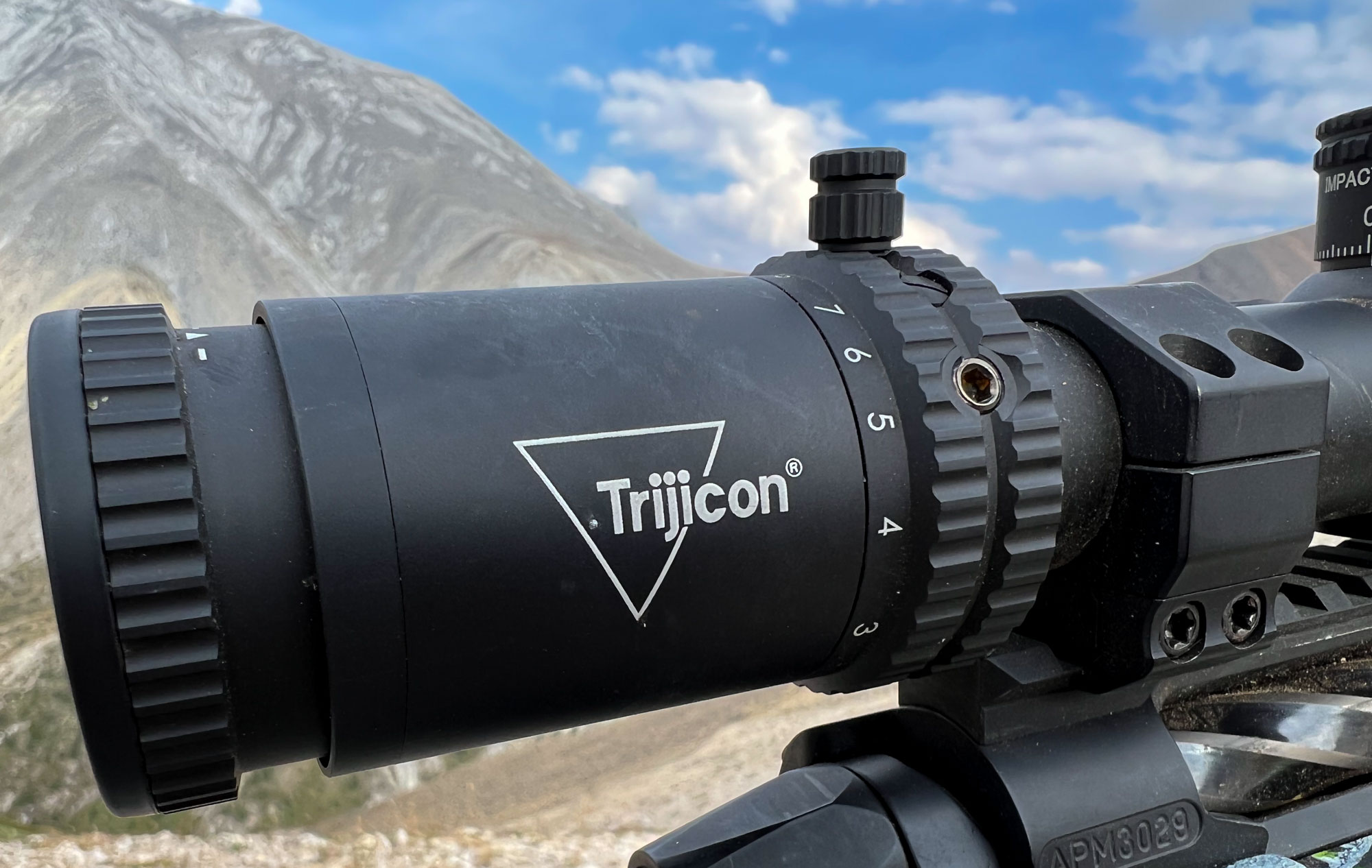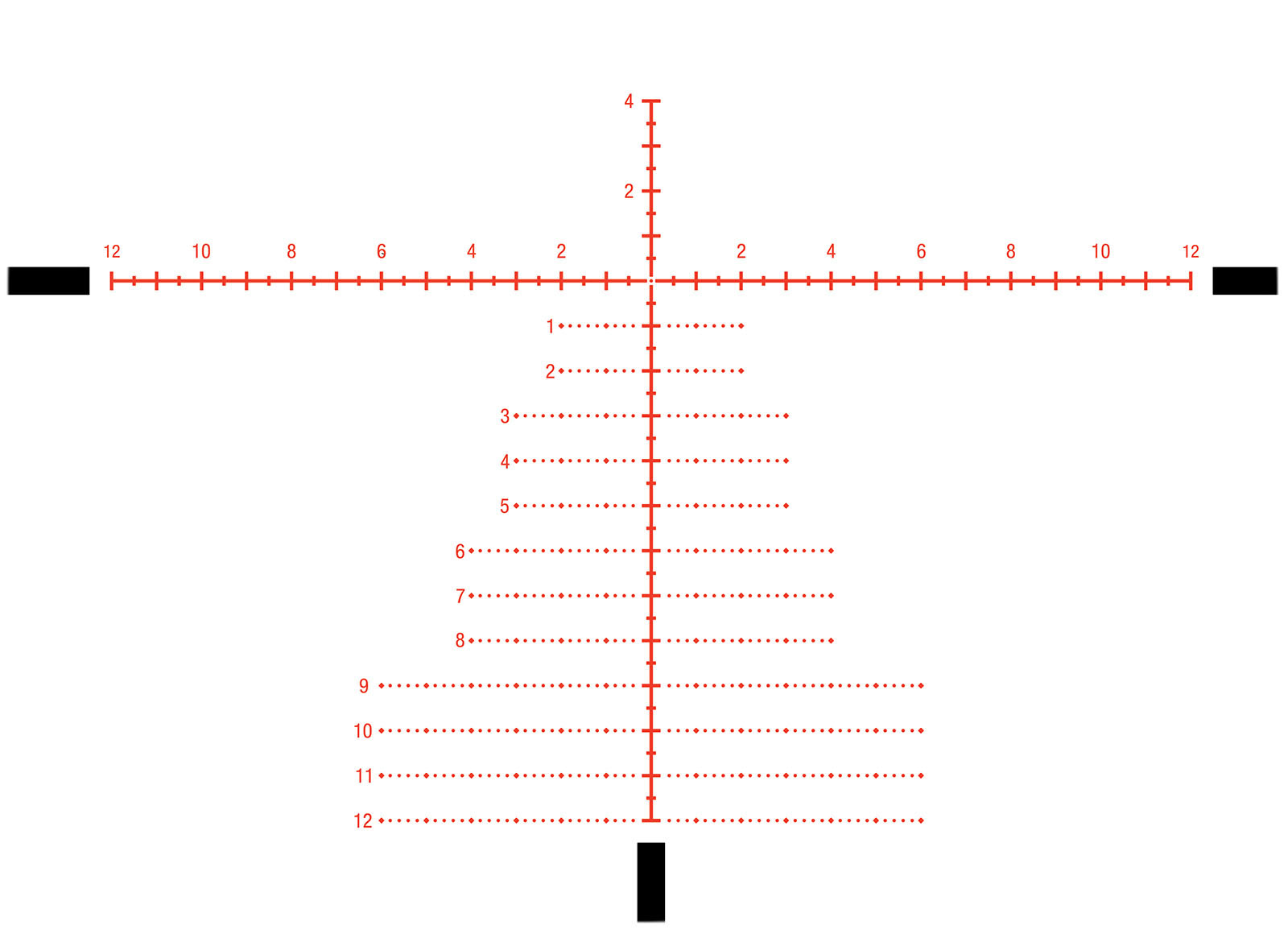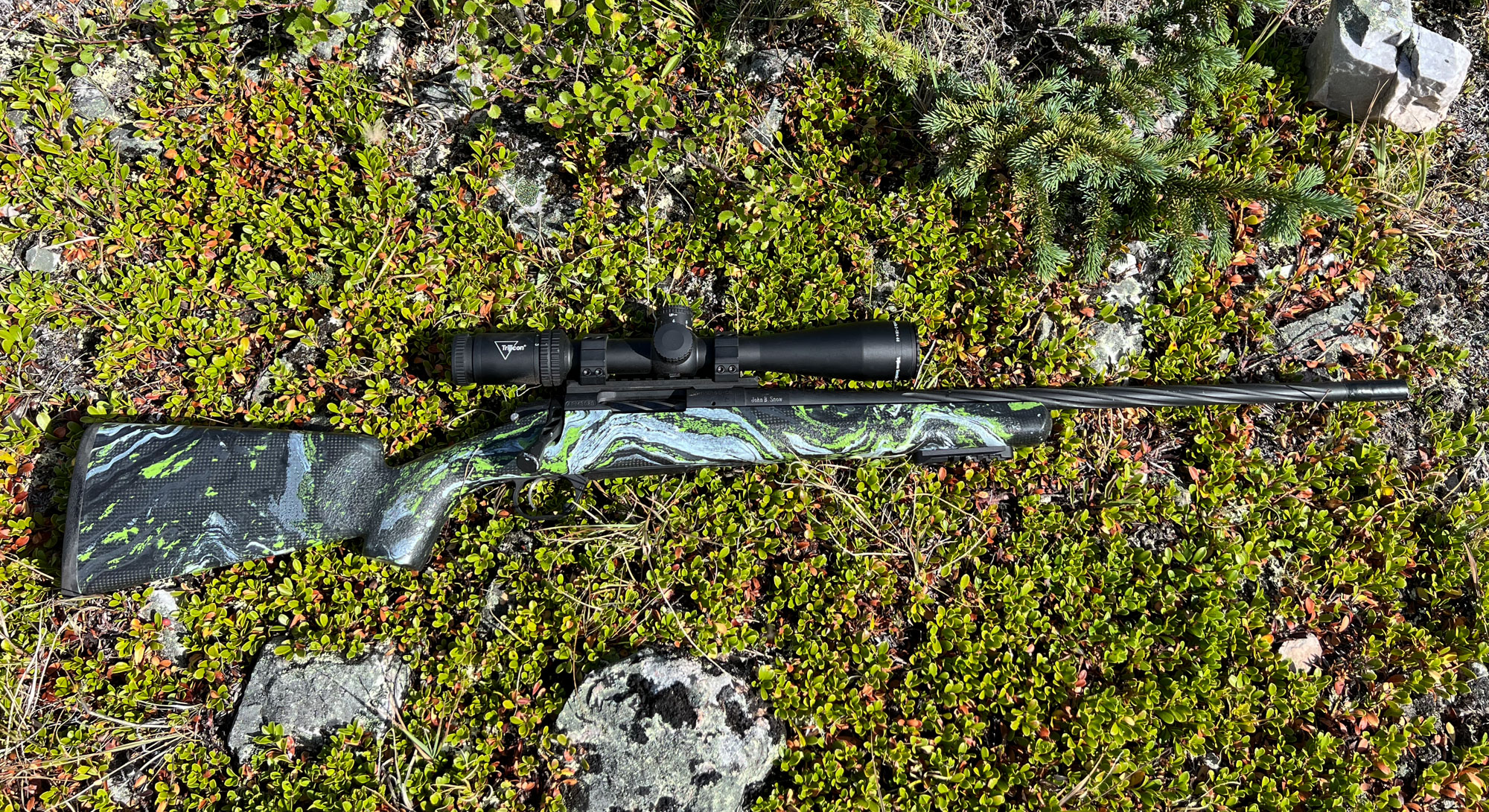The Trijicon Tenmile 3-18×44 first focal plane scope is a great example of the trend in products that bridge the realms of precision shooting and hunting. For technically inclined hunters who like to dial their dope for longer shots it is an appealing option. Over the years I’ve run three different samples of this scope on three different hunting rifles, which is a good indication of what I think about it.
Among its virtues are a magnification range (3X to 18X) that’ll cover just about any scenario encountered hunting open country, a well-designed reticle that incorporates useful detail without being overwhelming, durable construction, and a size and weight that isn’t burdensome for even extreme mountain hunting.
- Magnification: 3-18X
- Tube Diameter: 30mm
- Dimensions: 15.02 in. (L) x 3.26 in. (W) x 2.4 in (H)
- Weight: 24.4 oz.
- Reticle: MRAD precision tree
- Adjustments: .1 MRAD per click
- Turrets: Exposed elevation, capped windage
- Total Elevation Travel: 17.45 MRAD
- Focal Plane: First
- Illumination: 5 levels each of red and green
- Battery: 1 CR2023
- Price: $2,310 MSRP / $1,650 Street

Trijicon Tenmile Family
The Trijicon Tenmile 3-18×44 is one of six models in the Tenmile lineup, most of which are aimed specifically at long-range shooters. The Tenmile 4-24×50 is the other one in the family that can do double duty as a hunting optic, since it weighs 25.7 ounces—just 1.3 ounces more than the 3-18X—and shares similar dimensions. I’d still favor the 3-18X because I’d rather have the lower bottom magnification setting (3X vs. 4X) and I think the Christmas tree reticle on the 3-18X is superior to the plain MRAD crosshair on the 4-24X.
Trijicon Tenmile 4.5-30×56
The 4.5-30X56 is built on a 34mm tube, weighs 36 ounces, and is offered in two FFP ($2,810) and one SFP ($2,732) configurations. In FFP you have the choice of either an MRAD or MOA reticle while the SFP is MOA only. Its size, weight, and—to some degree—cost relegate it to dedicated long-range rifles.
Trijicon Tenmile 5-25×50
This is a SFP scope with a basic, almost minimalistic, MRAD reticle. It comes on a 30mm tube, weighs 25.6 ounces, and has .1 MRAD adjustments on the windage and elevation. For shooting disciplines on known-range targets it is a solid choice, especially for shooters that don’t care for FFP scopes. Because SFP scopes aren’t as expensive to build it carries a $2,100 price tag.
Trijicon Tenmile 5-50×56
This hefty scope (38.4 ounces) with its 10-times magnification range is meant for extreme long-range shooting. It is SFP only and can be had in MRAD or MOA configurations. To fine-tune the elevation on long shots, the MRAD version comes with .05 MRAD click adjustments, while the MOA model uses 1/8 MOA clicks. Thanks to its 34mm tube it has 29.1 mils/100 MOA of elevation on tap and 14.5 mils/50 MOA of windage. It costs $2,837.
Trjiicon Tenmile 6-24×50
This is another SFP scope that can be had in MRAD or MOA trim. It’s built on a 30mm tube, weighs 24.9 ounces, and is the least costly scope in the Tenmile lineup at $1,470. While lacking the versatility that FFP scopes bring the party, it is an economic choice for long-range shooters. The 6-24X magnification range it isn’t ideal for big game hunting but is right at home for ringing steel at long range and for controlling your local population of ground squirrels and prairie dogs.

Trijicon Tenmile 3-18×44 Controls
The controls on the scope are all easy to manipulate and generally well executed. All the elements that dial or adjust require the correct amount of effort to turn. Nothing is either too tight or too sloppy.
The layout of the controls is intuitive so there’s not much of a learning curve to get used to the scope. The markings on the scope are cleanly executed and easy to read. Though making the numbering a bit bolder, especially for those of us with aging eyes, would be a worthwhile upgrade.
Elevation and Windage Turrets
The elevation knob on the scope is exposed, while the windage knob is secured under a cap. This is the ideal setup for most precision rifle scopes and is absolutely the right choice for a precision hunting optic.
There is no benefit to having the windage knob permanently exposed. Under only the most peculiar circumstances would you ever want to dial windage while attempting a shot on game. Instead, you should rely on the hash marks in the reticle to make windage corrections. When a windage knob is hanging out there, unprotected, nothing but bad things can happen. Usually in the form of the knob getting knocked off its zero.
I had that happen to me a few years ago and it cost me a nice bull elk. If I’m ever hunting with a scope that has an exposed windage knob I wrap it with electrical tape after establishing the zero to make sure it doesn’t budge. I suggest you do the same.
The elevation knob is a little over .75 inches tall and has a raised knurled rim at the top to offer some grip. The knob turns easily and gives 8 mils of elevation per revolution. That’s enough for 1,000-yard shots with most high-performance cartridges.
The scope has more elevation than that on tap, however. Once I set the zero on my H-S Precision 7mm PRC I had 13.5 mils of elevation left, which would get me out to 1,450 yards or so before needing to hold over with the reticle. That’s much farther than I’d ever plan to shoot with that hunting rig, other than to mess around on steel.
The turret is only numbered from zero to seven mils with ticks at .1 mil intervals. So, if you dial beyond one revolution, you’re going to need to do some counting and math to keep track of the final elevation value.
If that’s an issue for you, Trijicon works with Kenton Industries to create custom turrets with more data (including a second row of numbers).
The scope gives good feedback with each click, though it isn’t as sharp as you’ll find on other premium scopes. I was able to dial by feel with my eyes closed, but found it required extra focus to keep from inadvertently adding extra clicks.

Zero Stop
The Trijicon Tenmile scopes all have zero stops that function the same way and can be set fairly easily. The top of the elevation turret unscrews, letting you remove the turret from the scope. That exposes the zero-stop mechanism. The scope comes with a small Allen-key wrench that’s used to loosen three set screws on the mechanism. Once they are loosened, you rotate the zero stop until the small post on the disk contacts another post fixed in the base of the mechanism. You then tighten the set screws and put the turret back on.
One thing I like about this zero stop is that you can set it to give you few clicks underneath the actual zero. When this option is available, I usually set it so the elevation turret can go .5 to 1 mil past zero. This gives you some cushion to reset the elevation if your scope gets knocked off (or if you have to switch to a new load) without having to fiddle with the zero stop.
The one thing I don’t like about the zero stop is that it is a bit mushy—at least on my scope. I want the stop to have a sharp, defined wall and mine has just a touch of play in it. It’s not a major flaw, but it is worth nothing.
Parallax
The parallax adjustment knob is on the left side of the scope and is just inside the dial that controls the reticle illumination. It is about half an inch wide and has a thin raised rim with machined knurling for better purchase. It rotates roughly three quarters of a turn (270 degrees) and is numbered from 15 yards to infinity.
The parallax can be dialed slightly closer than the 15-yard mark, and I was able to focus my reticle on objects 13 yards away. Being able to focus on objects so closely is a benefit when doing dry-fire practice in a confined space (like your house).

Illumination
Illumination on the Trijicon Tenmile 3-18×44 is controlled with dial that sits just outside the parallax focus. It has ten settings, five that light the reticule green and five that light it red. The values on the dial go from R1 to R5 one way, and G1 to G5 the other. Between each intensity level is an off position, which is a handy feature.
The switch turns freely in either direction, so you can keep spinning the dial to get to the position you want without coming against a stop. The reticle illumination is bright enough to use in full daylight on the fourth and fifth settings, while positions one through three will make the reticle visible in dimmer light without washing out the image.
The scope uses a single CR2023 battery that provides 39 hours of power on the highest red setting (R5) and 94 hours on the highest green setting (G5), according to Trijicon. The battery sits underneath a cap on the illumination dial that’s simple to unscrew and that’s sealed against the elements with a rubber gasket.
I didn’t test the battery’s duration in extreme cold—so I don’t know if those published figures would hold true in extreme conditions—but I’d always make sure to have a spare in my pack to change it in the field if need be.

Magnification Ring
The scope zooms from 3X to 18X with a half revolution of the magnification ring. The ring has a large, raised portion that’s about .67 inches wide and textured so that it gives a good handhold when adjusting the scope’s power.
The ring moves smoothly through its 180 degrees of travel. It is stiff enough so that it is unlikely to get knocked to a different setting inadvertently yet can be turned without undo effort.
The numbers on the ring are clearly marked and easy to read. The scope comes with a small stud that can be screwed into the ring to act as a throw lever. It extends .4 inches above the magnification ring and gives you extra leverage to adjust the magnification level. This is particularly useful when you’re set up behind the rifle and want to adjust the magnification without breaking your position.
Ocular Focus
The eyepiece focus on the Trijicon Tenmile 3-18×44 is a European style, meaning it doesn’t have a locking ring that secures it in place. Instead, it turns freely like the diopter adjustment on a binocular.
The tension on the focus ring is fairly stiff so it isn’t likely to get knocked out of position. But the ring has a “+ / –” etched on it with a triangle between them so you can tell where the focus is without needing to look through the scope. Once you set the focus for your eyes, I’d suggest dabbing a small dot of nail polish on the scope tube that’s in line with the triangle. That’ll let you return the focus to the correct place in a flash.

Trijicon’s MRAD Precision Tree Reticle
The main crosshairs on the Trijicon Tenmile 3-18×44’s reticle have hashmarks placed at .5 mil intervals with a central floating dot. The hash marks are smaller at the .5 mil positions, and larger on the whole values. In addition, the reticle is etched with even numbers, going from 2 to 12, above the corresponding hash mark on the horizontal crosshair.
It’s pretty easy to get oriented in the correct spot on the horizontal plane without a lot of practice. The layout is clean and uncluttered.
The “tree” beneath the horizontal crosshair has dots indicating windage in .2 mil intervals on “branches” at every full mil. Those branches are labeled 1 to 12 on the outer edge to help you orient yourself when holding over.
The width of the branches increases the farther you drop down the tree. At 1 and 2 mils, they extend two mils to the left and right of the central vertical crosshair. At 3, 4, and 5 mils, they provide 3 mils of windage dots. At 6, 7, and 8 mils, the branches extend 4 mil on either side. And from 9 to 12 mils the branches stick out 6 mils either way.
That layout is particularly useful when shooting distant prairie dogs where getting accurate ranges can be nearly impossible. But it is also good for making follow up shots on game in case you miss or need to fine-tune bullet placement.
The vertical portion of the crosshair extends 4 mils above the central aiming point and has the same layout as the horizontal crosshair—small hashes at .5 mil and larger hashes at the whole numbers.
Optical Quality
The glass in the scope is very good. It delivers a crisp clear image in the center of the view, with some distortion and loss of focus on the edges. Some degree of spherical aberration is normal and exists on even the highest-price optics.
In terms of color quality, the scope was excellent. I never experienced meaningful chromatic aberration with any of the samples I’ve used and have been happy with how they behaved under challenging conditions, such as when your target is nearly in line with the sun. All in all, the scope earns high marks for its glass.

Trijicon Tenmile 3-18×44 In The Field
As I said, I’ve mounted three different samples of this scope on three different hunting rifles over the years and have always been pleased with their performance. Most recently, I ran one on a two-week bighorn sheep hunt in Alberta that was about as physically demanding as any hunt I’ve ever done.
The scope withstood long miles on horseback, banging through willow thickets along the river and creek bottoms, and busting through the dense, trackless pine forests we had to traverse to get to the high country.
After that, the real fun began with lung-busting vertical ascents with my rifle strapped to my pack or slung over my shoulder. Much of that climbing involved literally hanging on for dear life, so there was no time to baby my gear.
I took a fairly serious tumble at one point, sliding 40 yards down a steep slope of jagged shale, mud and ice. I came to a stop right above a plunging waterfall that would have spelt serious trouble had I gone into it, but as it was everything on me—including me—was pretty beat up. Other than getting scratched and smeared with mud, however, the rifle and scope held up fine. (I did a full review of the rifle, an Allterra Arms Mountain Shadow Steel, that includes pictures of the Trijicon Tenmile.)
The scope also survived more typical abuse—ice and snow, rain, dust—without any issues. Trijicon has a long-standing reputation for making durable optics—I don’t know of anything more rugged than a Trijcon ACOG—and the Tenmile scopes seem to be cut from the same cloth.
The newest Trijicon Tenmile 3-18×44 in my collection is on the H-S Precision rifle pictured below. I’m still in the process of gathering accuracy data and putting the rifle through a series of shooting drills before my review is final, but so far the scope has complimented the 7mm PRC well. I’ve done some shooting with it at longer ranges, as I did with the Allterra Arms rifle, and found that the scopes on both guns tracked well and had no issues returning to zero.

What the Tenmile 3-18×44 Does Well
This scope hits a sweet spot that other companies are likely to emulate. It’s a FFP optic in a useful magnification range that isn’t too bulky and is priced fairly. I also like the fact that it is MRAD based. While plenty of hunters and shooters will debate the merits of MOA vs MRAD, I gravitate toward mils for practical long-range applications. Milliradians, designed on a base-10 system, are more intuitive and require less math to employ than minutes of angle.
Though if you’re a died-in-the-wool MOA shooter, but like what you’ve read about this scope here, look at the Trijicon Tenmile HX 3-18×44. The Tenmile HX scopes are all MOA-only designs.

What the Scope Could Do Better
The list of things I’d change on the Tenmile 3-18×44 is pretty short. I’d like to see the numbers on the scope marked more boldly and a second row of elevation values placed on the turret. I also think the clicks when dialing elevation could be a bit sharper to give better tactile feedback and control.
Read Next: Best New Precision Rifle Scopes
Final Thoughts on the Trijicon Tenmile 3-18×44
I’m a big fan of this scope as evidenced by the fact that I’ve mounted it on several of my favorite rifles and have trusted it enough to take it on some very big hunts.
For a hunter looking to make the leap from a second focal plane scope, and who’s interested in using an MRAD based optic, there aren’t many scopes that measure up to it.
